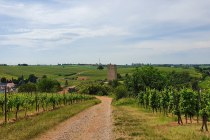Niersteiner Schloss Schwabsburg (Schwabsburg Castle in Nierstein)
Old castle walls and Riesling
Where once was a castle, today only the castle tower is left. It is not known who built the castle. Historians estimate that it was built between 1125 and 1245 during the Staufer period. Hikers can picnic on the lawn in front of the ruins. The single vineyard is named after the former castle. A variety of grape varieties grow on loess and red sandstone, mainly Riesling. The wines are dense with intense aromas.
> Discover the single vineyard via the Five Towers Hike: https://rhein-selz-geht-aus.de/unterwegs-in-rhein-selz/fuenf-tuerme-wanderung-zwischen-oppenheim-und-nierstein.html
> About the regional history of Schwabsburg: https://www.regionalgeschichte.net/rheinhessen/nierstein/kulturdenkmaeler/schwabsburg.html

























